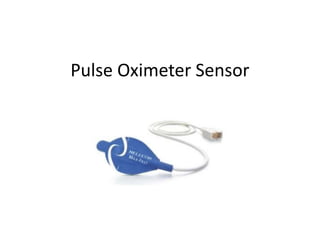
pulse oximetry final
- 2. Our Goal We hope to quantify the dynamics of an active muscle. LED spectroscopy provides a way to track fatigue and oxygen trends of an area of interest.
- 6. Properties of the Red and IR LED • Near-IR light has much better penetration into biological tissue than visible light • NIR light absorption affected by: hemoglobin, myoglobin and cytochrome c oxidase molecules (90%Hb) • To track specifically muscle activity, it appears that Infrared light will be the most appropriate signal to track
- 7. IR signal We know from Beer-Lambert’s law that the absorption of an LED is a function of each absorbed substance given their: 1. extinction factor 2. concentration 3. path length. Our IR light detects mostly Hb/Mb-deoxygenation in muscle tissue but we cannot account for path length using 1 LED.
- 8. Path Length For a fixed optode (forehead) we could assume path length to be constant. However, we are interested in quantifying muscle movement within exercise, and our signal includes an initial contraction of muscle (change of path length)
- 9. Accounting for path length The optical path length was accounted for by measuring the absorbance changes obtained during cuff ischemia. The percent deoxygenation during exercise is then calculated from the maximal deoxygenation of the ischemic response. A way of normalizing NIRS signals across subjects.
- 10. Oxygen saturations Boushel claims one must use multiple wavelengths to generate algorithms for NIRS. • Coefficients used at each wavelength deconvolute the overlapping absorption spectra. • Algorithms are used for either trend monitoring or to assess relative concentrations.
- 11. Below are wavelengths and coefficients used in the laboratory at Duke for assessing relative concentrations.
- 12. Measurements with Two Wavelengths Other NIRS applications use two near-IR LEDs (760 and 850nm) and use the difference between the signals to determine relative oxygen saturation. The sum of the signals to provide a reference to blood volume changes.
- 13. Red-IR= relative O2 While I am using a Red LED and IR LED, the data shows plausible oxygen trends in that the bicep oxygen content desaturates with increased load in isometric exercise.
- 14. Infrared Trends We changed the experiment set up Infrared signals have shown a promising fatigue trend in almost all of our samples.
- 16. Analyzing IR trends Static load in some types of activity compromise blood flow to working muscle. Are our IR decline trends due to decreased blood flow, or is the use of oxygen in the muscle exceeding a continuous supply?
- 17. Moving Forward Ultrasound & IR signal of Nellcor sensor in cooperation. Separate muscle influence and oxygen Classify experiment activity, static load or active Use multiple NIRS LEDs? • Overlapping spectra= trend monitoring/ find relative concentrations of each molecule.
Notes de l'éditeur
- The basis for our sensor are two LED signals, Red and Infrared. They have wavelengths of 660 and 910nm, respectively.
- When there is high oxygen saturation, the IR pulse amplitude is higher, and Red pulse amplitude greater for lower oxygen saturation. A red-to-infrared pulse modulation ratio is needed to determine Oxygen saturation.
- We have a Nellcor SpO2 Forehead Sensor that was designed to track poor pulse perfusion as fast as possible as arterial blood reaches the head before the fingers. Nellcor products have monitors that account for calibration curves that correlate the pulse Modulation Ratio to oxygen saturation. Using that system, oxygen content for an area of interest is easily monitored. However, we are using a TI SP02-FE EVM dac that allows us to capture raw Infrared and Red LED signals from the sensor.
- A chromophore is the part of a molecule responsible for its color. The color arises when a molecule absorbs certain wavelengths of visible light and transmits or reflects others.
- Cut off the supply of oxygen to the area of interest and use the max deoxygenation measurement to calculate the oxygenation during exercise
- (scaled to the maximum and minimum values). However, without accounting for the influence of tissue and the change within the muscle, there exists the problem of normalizing the data between people, and determining true oxygen saturation changes. You can also see some activity in the signal with the contraction in the first few seconds, and it doesn’t seem intuitive to assume that is due to oxygen saturation changes over milliseconds.
- The experiments were taken over 5 minutes with the subject maintaining a steady force of 30% of their maximum contraction against a table top. They were seated with their arm at about 90 degrees, without any support and the maximum force was calibrated for each person. HOPES: to track fatigue over a longer time period, paying attention to IR and less on initial contraction fluctuations in the data— put aside path length
- We hope to get an ultrasound that will be able to track muscle diameter in cooperation with the Nellcor sensor’s Infrared signal. Ideally, the ultrasound will be a useful tool to provide a real-time picture of the muscle, and I think we will be able to better account for the muscle thickness in the individual signal. Something we may want to consider is using multiple Near-Infrared LEDs as they penetrate to the muscular level well. We could explore how to deconvolute the overlapping absorption spectra to trend monitoring or to assess relative concentrations. Keep in mind the type of activity we are tracking– keep in mind the intramuscular pressure and it’s affect on blood flow.